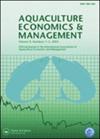Consumers’ willingness-to-pay for convenient catfish products: Results from experimental auctions in Arkansas
IF 3.8
2区 经济学
Q1 AGRICULTURAL ECONOMICS & POLICY
引用次数: 7
Abstract
Abstract This study has examined consumers’ acceptance, preference, and willingness to pay (WTP) for five newly developed convenient (ready-to-cook) catfish products. The University of Arkansas at Pine Bluff, in collaboration with Texas State University and USDA Agricultural Research Services, New Orleans, has developed these products. We have collected data from 121 catfish consumers of Arkansas through 18 experimental auction sessions (Vickrey’s second-price auction). Participants evaluated the products’ sensory attributes (appearance, color, glossiness, and serving size). They elicited their WTP for each of the products through bid (quoted price) in separate sealed envelopes. Consumers’ acceptance of various product attributes was measured using a hedonic scale (Likert scale) and just about right (JAR) scale. We have measured consumers’ preferences for the products and their attributes through two-way internal preference mapping (Principal Component Analysis) and three-way internal preference mapping (Parallel Factor Analysis—PARAFAC). We have examined the role of consumers’ acceptance level for product attributes and the participants’ socioeconomic characteristics on their WTP using the Tobit model. The study revealed that the acceptance level for panko-breaded products was higher than marinated products. Consumers preferred breaded products to marinated products. The WTP for a product was higher with the higher acceptance ratings for product attributes, young participants, and African–American catfish consumers. There was a negative relation between the participants’ education level (dummy for bachelor’s degree holders) and their WTP. The study concluded that all the newly developed catfish products are likely to be successful as future seafood products in the market.消费者购买方便鲶鱼产品的意愿:阿肯色州实验性拍卖结果
摘要本研究考察了消费者对五种新开发的方便(即煮)鲶鱼产品的接受度、偏好和支付意愿。阿肯色大学派恩布拉夫分校与德克萨斯州立大学和美国农业部新奥尔良农业研究服务中心合作开发了这些产品。我们通过18次实验性拍卖(Vickrey的第二次价格拍卖)收集了阿肯色州121名鲶鱼消费者的数据。参与者评估了产品的感官特性(外观、颜色、光泽度和份量)。他们通过单独密封信封中的投标(报价)得出每种产品的WTP。消费者对各种产品属性的接受度是使用享乐量表(Likert量表)和恰到好处的量表(JAR)来衡量的。我们通过双向内部偏好映射(主成分分析)和三元内部偏好映射,测量了消费者对产品及其属性的偏好。我们使用Tobit模型研究了消费者对产品属性的接受水平和参与者的社会经济特征对其WTP的影响。研究表明,面包制品的可接受程度高于腌制制品。比起腌制品,消费者更喜欢面包制品。产品的WTP越高,产品属性、年轻参与者和非裔美国人鲶鱼消费者的接受度越高。参与者的教育水平(学士学位持有者的假人)和他们的WTP之间存在负相关。研究得出结论,所有新开发的鲶鱼产品都有可能成为市场上未来的海鲜产品。
本文章由计算机程序翻译,如有差异,请以英文原文为准。
求助全文
约1分钟内获得全文
求助全文
来源期刊

Aquaculture Economics & Management
FISHERIES-
CiteScore
7.30
自引率
17.90%
发文量
21
期刊介绍:
Aquaculture Economics and Management is a peer-reviewed, international journal which aims to encourage the application of economic analysis to the management, modeling, and planning of aquaculture in public and private sectors. The journal publishes original, high quality papers related to all aspects of aquaculture economics and management including aquaculture production and farm management, innovation and technology adoption, processing and distribution, marketing, consumer behavior and pricing, international trade, policy analysis, and the role of aquaculture in food security, livelihoods, and environmental management. Papers are peer reviewed and evaluated for their scientific merits and contributions.
 求助内容:
求助内容: 应助结果提醒方式:
应助结果提醒方式:


